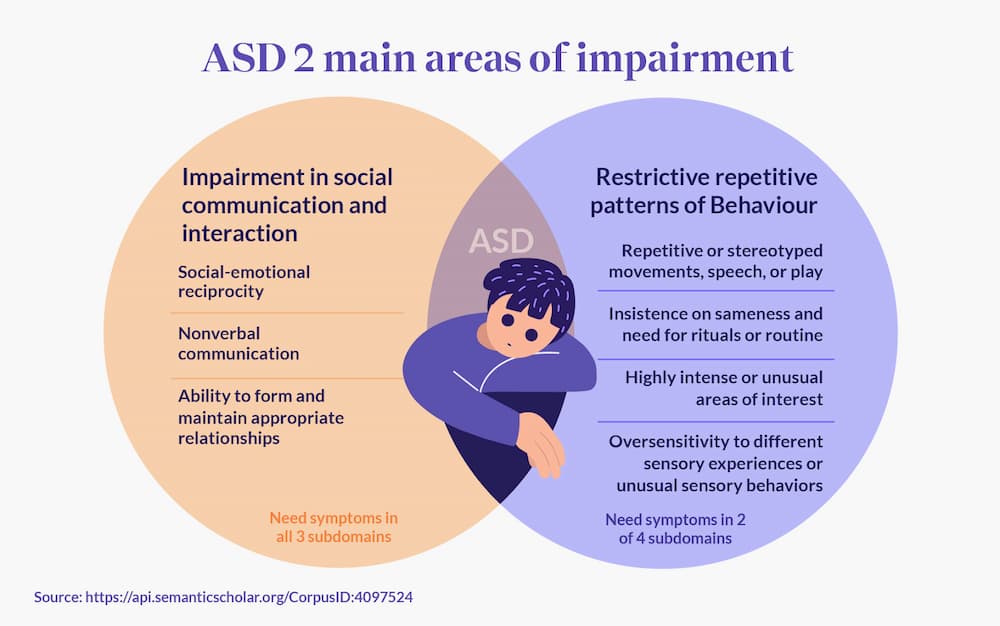Daily life hacks that Autism Spectrum Therapies professionals use successfully
Wiki Article
Comprehending the Impact of Behavioral Autism on Every Day Life and Social Interactions
You might not understand just how deeply behavior autism impacts life and social communications. People on the range frequently browse a globe filled up with interaction obstacles and sensory overload. These challenges can lead to frustration and seclusion, impacting their connections and overall well-being. Recognizing these subtleties is crucial for fostering encouraging settings. What techniques can we execute to produce more purposeful links and comprehensive spaces? The answers may stun you.Defining Behavior Autism and Its Qualities
Behavioral autism, commonly referred to as autism spectrum problem (ASD), encompasses an array of conditions identified by challenges in social interaction, interaction, and repeated actions. You could notice that people with ASD often have a hard time to interpret social cues, which can lead to misunderstandings in discussions. They might discover it tough to establish eye get in touch with or engage in tiny talk, making social scenarios feel overwhelming.Interaction problems can materialize in numerous means, from postponed speech advancement to a choice for using fewer words. By acknowledging these characteristics, you can promote an environment that advertises approval and encourages efficient communication, assisting people with autism grow in their everyday communications.
The Range of Autism: Comprehending Variability in Behavior
Autism spectrum problem (ASD) isn't a one-size-fits-all diagnosis; it varies widely amongst individuals. You might experience people who are very verbal and involve conveniently in conversations, while others may like singular tasks or connect non-verbally.In addition, the method individuals with ASD react to sensory input can vary greatly; some may be bewildered by brilliant lights or loud noises, whereas others prosper in promoting settings. The range additionally includes differences in social interactions; some individuals might have a hard time to translate social hints, while others navigate social setups with relative ease. Understanding this variability is vital, as it helps you appreciate each person's one-of-a-kind experience and tailor support to their specific requirements, cultivating a much more inclusive environment for everyone.
Communication Challenges Encountered by Individuals With Autism
When you interact with individuals on the autism range, you may see their distinct interaction obstacles. They usually deal with problems with both spoken and nonverbal signs, which can affect their social communications. Understanding these barriers is crucial for promoting far better connections and support.
Verbal Interaction Troubles
Numerous individuals on the autism range experience verbal interaction troubles that can considerably influence their day-to-day interactions. You could find it testing to express your ideas, sensations, or needs plainly. This can bring about disappointment for both you and those around you, as misconceptions take place. You might fight with starting conversations, preserving a topic, or understanding subtleties in speech. Frequently, you may choose utilizing easy language or repetitive phrases, which can restrict your capability to participate in deeper conversations. Your volume, tone, or speed might not align with social expectations, triggering others to misinterpret your purposes. Recognizing these challenges can assist you and your assistance network develop methods to improve communication and promote much better connections with others in your life.Nonverbal Interaction Obstacles
Spoken communication isn't the only obstacle individuals on the autism spectrum face; nonverbal interaction barriers can be just as considerable. These difficulties can lead to misconceptions or misinterpretations of social hints, making interactions feel complicated or overwhelming. By attending to nonverbal communication, you can find methods to improve your social experiences and improve your general high quality of life.Social Communication Influences
Social interactions can commonly feel overwhelming due to the unique interaction obstacles faced by individuals with autism. You may fight with translating social cues, making it difficult to recognize mockery or body language. This can lead to misconceptions or uncomfortable moments in discussions. Additionally, initiating and preserving discussions might really feel tough, causing stress and anxiety in social scenarios. You might favor structured settings, making spontaneous communications unpleasant. It's additionally usual to experience problem in participating in small talk, which can impede forming new relationships. Recognizing these difficulties can aid you locate strategies to boost communication, such as exercising social skills in safe settings or making use of aesthetic aids - Autism Therapist. Comprehending your demands allows you to browse social interactions with better confidence and simplicity.Social Interaction and Relationship Structure in Autism
While building partnerships can be testing for people with autism, recognizing their distinct point of views and interaction designs can foster significant connections. You might discover that many people on the range choose straight communication and may have a hard time with social cues or small talk. By being straightforward in your communications, you can help create a setting where they really feel comfy.Make the effort to observe and listen exactly how they reveal themselves. This understanding can guide you in guiding discussions better. Taking part in shared interests can also offer as a bridge to much deeper links. Whether it's a leisure activity, a favorite show, or a shared enthusiasm, these usual strings can open up doors to friendship.
Every Day Life Routine: Navigating Difficulties and Strategies
Steering life regimens can be especially challenging for people with autism, particularly when unforeseen adjustments occur. You may discover comfort in having a structured schedule, as it helps you expect what's next. When interruptions take place, it's regular to feel distressed or overloaded. To browse these challenges, consider applying aesthetic timetables or checklists. These tools can supply clearness and reassurance.Establishing a routine that includes sensory breaks can likewise be advantageous. This helps produce an understanding environment.
Finally, method mindfulness techniques to handle tension and check over here anxiety. Straightforward breathing exercises or grounding techniques can make a considerable difference. By incorporating these methods, you can enhance your daily routine and reduce disruptions, making life really feel extra manageable.
Strengths and Abilities of People on the Autism Range
Recognizing everyday life regimens is simply one element of the autism experience. Numerous individuals on the autism range possess impressive staminas and capacities that set them apart. You might locate that your focus to detail is exceptional, enabling you to excel in tasks that need precision and emphasis. Your ability to think outside package can bring about ingenious remedies in numerous situations.In addition, your memory abilities usually beam, especially in locations of rate of interest. Autism Therapist. This propensity for maintaining information can make you an important source in fields like science, modern technology, or art. You may additionally exhibit strong aesthetic reasoning, enabling you to picture intricate principles and fix problems artistically
In addition, your special point of view on the world can foster empathy and understanding in others, enriching social communications. Accepting these strengths not just boosts your self-confidence but also aids others appreciate the diverse skills you offer the table.
Developing Comprehensive Settings for People With Autism
Developing inclusive atmospheres for people with autism starts with creating sensory-friendly rooms that cater to their unique needs. You can also promote chances for social interaction, helping to construct links and relationships. By making these modifications, you'll add to a much more welcoming ambience for every person.Creating Sensory-Friendly Spaces
While developing sensory-friendly rooms, it's important to assess the one-of-a-kind demands of individuals with autism. Start by selecting soothing shades and soft illumination to produce a relaxing environment. When overwhelmed, include quiet zones where individuals can recharge and retreat. You'll want to lessen loud sounds and distractions, utilizing soundproof products or white sound machines to assist keep tranquility. Think about tactile elements like soft textiles or fidget-friendly items that can supply comfort. Ascertain that areas are adaptable, enabling for easy reformation to fit different tasks. Consist of aesthetic timetables or clear signs to assist people browse the room confidently. By thoughtfully integrating these components, you can produce an inviting atmosphere that sustains sensory demands and advertises general well-being.Advertising Social Communication Opportunities
Designing sensory-friendly areas not only addresses individual comfort but also establishes the phase for meaningful social interactions among people with autism. To promote these communications, create inclusive atmospheres that invite involvement. Organize structured activities, like art courses or group games, that encourage cooperation without frustrating sensory input. Use aesthetic aids and clear communication to aid every person involve conveniently. Encourage peer mentoring, combining individuals with autism with supportive peers that can direct them via social situations. In addition, take into consideration organizing normal area occasions that celebrate neurodiversity, promoting approval and understanding amongst all participants. By applying these techniques, you can improve social chances, helping individuals with autism construct relationships and enhance their social skills in a risk-free, welcoming environment.
Frequently Asked Questions
Exactly How Can Friends Assistance Someone With Behavioral Autism?
You can support a pal with behavior autism by holding your useful reference horses, listening proactively, and valuing their boundaries. Take part in activities they appreciate, communicate honestly, and produce a comfortable setting where they feel valued and comprehended.What Resources Are Offered for Moms And Dads of Children With Autism?
You can explore various sources for moms and dads of kids with autism, including assistance teams, instructional websites, and neighborhood neighborhood solutions. Connecting with various other moms and dads can additionally give important understandings and shared experiences to aid browse difficulties.
Can Behavioral Autism Modification In Time?

Yes, behavioral autism can transform with time. You might observe shifts in interaction, social abilities, and behavior as your youngster grows. Early treatment and support typically read this post here play vital roles in these developmental adjustments.
How Do Sensory Level Of Sensitivities Affect Life?
Sensory level of sensitivities can make daily experiences overwhelming. You may have a hard time with intense lights or loud sounds, resulting in tension or evasion. Locating settings that accommodate your needs can considerably boost your convenience and overall life.What Prevail Misconceptions Regarding Behavioral Autism?
You might believe behavior autism just impacts interaction skills, yet it's more complex. Numerous assume individuals lack compassion or knowledge, which isn't true. Recognizing these misconceptions assists foster approval and support for those on the range.Behavior autism, frequently referred to as autism spectrum disorder (ASD), incorporates a variety of problems defined by challenges in social communication, interaction, and repeated actions.Social interactions can frequently really feel overwhelming due to the special interaction obstacles dealt with by people with autism.Designing sensory-friendly spaces not only addresses specific comfort however likewise sets the stage for purposeful social communications among people with autism. Encourage peer mentoring, matching people with autism with encouraging peers who can guide them via social circumstances. By executing these techniques, you can improve social opportunities, aiding individuals with autism develop friendships and strengthen their social skills in a secure, inviting atmosphere.
Report this wiki page